Can Cyberpunk be Fun?: Upload (2020-) as Smart Comedy TV series by Greg Daniels and Howard Klein
We got accustomed from the beginning of the 20th Century to the idea of a gloomy future with the advent of AIs, ousting humans and wreaking havoc of human feelings and civilization, especially in SF drama in the theatre and on the screen—from Čapek’s R.U.R through Blade Runner to Black Mirror and Altered Carbon. Along the way, the definition of humanity was expanded, and the abilities of AI now encompass what we consider core human qualities and values. But all that was predominantly developed closer to the tragic side of the dramatic spectrum, if done with any depth. The series Upload that premiered May 1, 2020 offered a lighter take on the theme, following the developing romantic story between the former coder Nathan Brown, newly uploaded into the digital sphere, and Nora Antony—his “angel” service agent of the corporation managing the simulated environment. I am suggesting the analysis of the cyberpunk romantic comedy gains in comparison with the development of the depicted human relationships in classic cyberpunk texts, such as Pat Cadigan’s Synners, and more contemporary ones, as the episode “San Junipero” in Black Mirror.
The first season of Amazon-produced show Upload caused an amazingly equal approval of both the critics and the public 87% and 88% on Rotten Tomatoes. Another new Greg Daniels’ show that premiered almost simultaneously—Space Force with Steve Carrell—didn’t achieve such unanimity by half: critics 39% and public 77%. Charm and wit of romantic comedy in combination with social satire are the two most lauded productively implemented aspects in Upload.
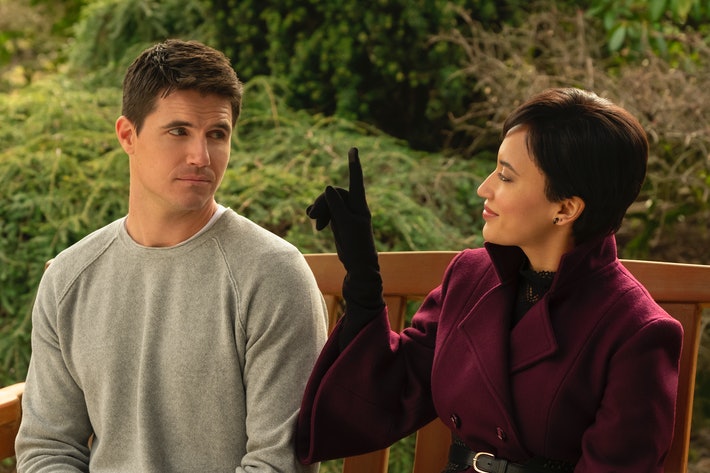
The tone of Upload appeared to be a right mixture of dark and light comedy—smart comedy, whereas Space Force tended more to the buffoon, though it definitely portrayed some more serious issues around the favorite toy idea of the present Trump administration of putting “American boots on the Moon again”.
The authors of Upload are exploring cyberpunk potential for overcoming somber overtones of the transhumanistic stage through very recognizable situations, which due to the addition of digital tweak reveal true sentiments and thoughts even better. One of the most poignant scenes in the show is Nathan’s funeral attended by his virtual self on the other side of a transparent screen-wall.
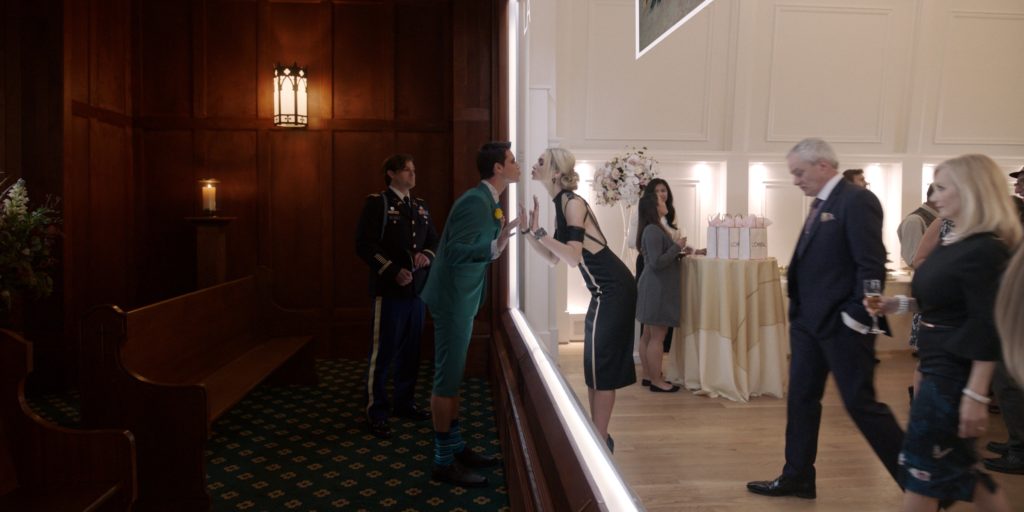
It soon becomes painfully obvious that Nathan’s socialite girlfriend Ingrid who is paying for continuation of his existence is more concerned with how she looks as an organizer of this memorial than with hurting Nathan’s feelings. She is literally showcasing him and herself. This scene also brings together his former friends and former girlfriends in a chapel to where this scene is broadcast with different stages of grudges against him and a few fond memories serving as a contrast to Ingrid’s behavior. Visually this scene is designed as all other interiors by Rachel O’Toole, with a contrast of cosy warm tones for afterlife, harsh light for real California and blue tints of the Brooklyn office.

We meet Nathan’s curator Nora—his uploading ‘angel’—at the moment in her life when she is very concerned about losing her father forever to cancer as he is refusing uploading on religious grounds, hoping to meet his deceased wife in “real Heaven”. Her intervention with unhappy Nathan heading for the destructing datastream is motivated at first by raising her approval rating to ensure the discount for her father’s upload. Her storyline is essentially restoring Nathan’s will to live and search for truth about his death and eventually leads him to caring for Nora’s fate. They are people with palpable ties to the world which makes them more relatable and more enduring narratively than many loner cyberpunk characters.
Active interaction between the real and virtual worlds captivated me as a viewer the most. They did not exist separately, uploading is depicted as a commodity, even if costly enough. Thus the company providing virtual immortality is aptly called Horizen—transparently hinting at Verizon—in a multilevel Lakeview hotel facility and its vicinities coded around.

From time to time even in a carefully maintained environment there happen glitches—one of them reducing characters traveling through the forest to low-resolution figures.


Daniels’ idea of Upload gestated for a long time—since 1980s, long before another digital hereafter variant (Black Mirror 3×4) won two Emmys in 2017. Kelly in the “San Junipero” episode was only visiting, not willing to ‘pass over’ permanently because her late husband didn’t want to stay in the world without their daughter who perished ten years ago before the virtual world became accessible.
By the vehemency of her refusal to “pass over” Kelly very much reminds of Gina from Synners, the 1991 novel by Pat Cadigan. Gina loved her creative companion and partner of many years Visual Mark, but was always more rooted in the reality with its nuances and excesses as compared to his submergence in the virtualities. And she refused to follow him irretrievably into the net as she cherished the intensity of life and connections in the real world, her camaraderie and budding love for a renegade former commercial ad creator Gabe Ludovic. With Gabe they literally fight the malignant power-greedy entity in virtual reality to become whole together and emerge to new life outside.
For Kelly, the reason of initial negation is the undeniable reality of the life she had with her husband—49 years of feelings and memories. But in the end she chooses to join York, whom she first married just to give a terminal paraplegic, who due to parents aggressive denial have never actually lived, a way to exist in the simulation. Because for Kelly herself this marriage will be a chance to live with her a life she has never before had the audacity to try – as the song goes:
“In this world we are just beginning // To understand the miracle of living.”
Layers of extra meanings around the concept of virtual heaven on earth are already at least 40 years deep since the emergence of cyberpunk. In Upload we are gliding along some trodden paths, but also look deeper into the economic basis of such added existence. Due to climate change only rich people can afford natural-grown food, everyone else eats 3D-printed, synthesized food. Unemployment might keep you out of heaven.
Richard Amell says, from the position of his character Nathan: “Being uploaded and essentially being owned as a human being, or as intellectual property, by my girlfriend throws a huge wrench in my life. So although I get to continue living, it’s definitely not on my own terms.” [Considine, April 22, 2020]. Starting from the moment he is carted into the clinic after a self-driving car crash, when we see two arrows showing directions to surgery or upload.
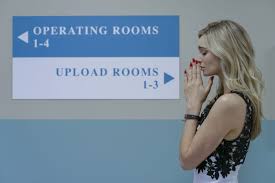
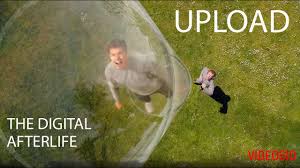
Nathan chooses then to go searching for a way to free himself in other layers of virtual existence which appear to be less developed and more precarious, and in the season finale, when it appears he needs to sort out his previous life, moves consciously to the lowest level of Lakeview of “Two Gigs” – where freedom to function is limited by 2 GB of memory a month.
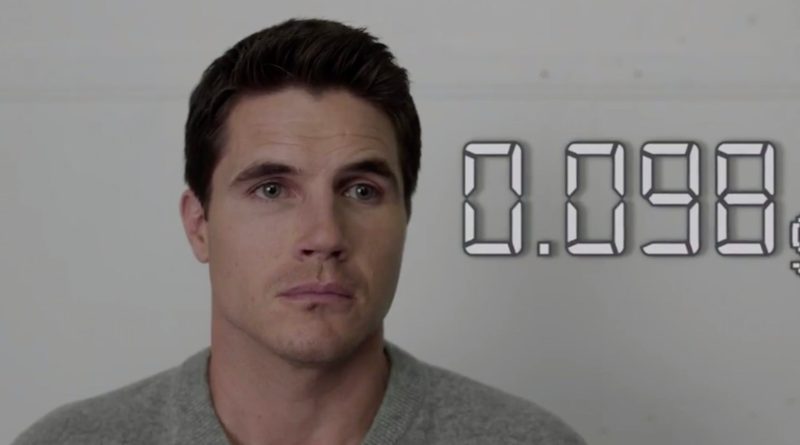
Upload here follows the same path as Cadigan’s classic cyberpunk, which Gwyneth Jones called “a prescient investigation of the unholy marriage between digital technology and the profit motive” [Jones, 2003]
Genuine feelings help to break away from the routine and malignant cycles—be it of societal conventions or corporate greed. Any comedy becomes possible upon the theme gaining a certain amount of stereotypes to overcome. With virtual reality, it is its very possibility to replace reality. This assumption contains a deep pocket of uncanny allusions throughout SF literature and film. Upload advent may designate that we as a community of readers and viewers might have arrived to the point where the authors found the way to create safe markers in the virtual world making possible to navigate it without totally loosing oneself there. And they appear to exist in old human feelings the veracity of which serves as a compass.
References
- Cadigan, Pat. Synners. NY,Bantam Books, 1991
- Considine, Austin. With ‘Upload,’ Greg Daniels Takes a Leap Into the Great Unknown. The New York Times, April 22, 2020 https://www.nytimes.com/2020/04/22/arts/television/upload-amazon.html
- Jones, Gwyneth. Top 10 science fiction by women writers, Guardian, December 8,2003
- Izon, Juliet. How Production Designer Rachel O’Toole Created Upload’s Brilliant Near-Future Sets, Architectural Digest, May 2020 https://www.architecturaldigest.com/story/upload-set-design
For any further info, contact Larisa at larmih@gmail.com
Discord Discussion
This discussion has been copied from the Discord server, names have been reduced to first name, discussion threads have been grouped and edited for better readability.